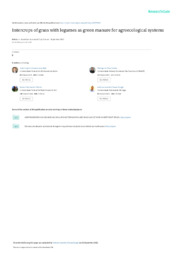Intercrops of grass with legumes as green manure for agroecological systems.
Intercrops of grass with legumes as green manure for agroecological systems.
Author(s): GUT, G. A. P.; EMERENCIANO NETO, J. V.; SANTO, R. da S.; MELO, R. F. de; NOGUEIRA, D. M.; DIFANTE, G. dos S.; GURGEL, A. L. C.; SANTANA, I. L. O.
Summary: The stud article aimed to assess the accumulation and rates of nutrients in the biomass of the consortium of millet and leguminous plants for green fertilisation. The treatments were consortia of millet with four different leguminous plants: Cajanus cajan, Canavalia ensiformis, Mucuna aterrima, and Dolichos lablab. The treatments were distributed in a completely randomised design with four replications. The species of each consortium were planted in a line, at a distance of one metre apart. The aerial part of the plants was harvested after 90 days to determine the botanical composition, intercropping biomass, and the amount and accumulation of macronutrients in the biomass. The Millet mass did not differ among the consortia. However, among the legumes, M. aterrima has the highest mass (2806.31 kg/ha DM), which is reflected in the lower ratio of leguminous grasses in the millet consortium with M. aterrima (4.61). The consortia affected the rate and accumulation of P, B, and Fe. The biomass of the millet consortium with C. cajan presented the lowest rate. In addition, the accumulation of K, Mg, and Zn was low in this consortium. The biomass of millet intercrops with M. aterrima, D. lablab and C. ensiformis showed higher accumulations of K, Ca, and Mg. The highest accumulation of N was observed in the biomass of the consortium with M. aterrima (50.71 kg/ha). The rates and accumulations of Cu and Zn were higher in the consortium with M. aterrima. The consortium of millet with the leguminous plants is a sustainable alternative for fertilisation. The consortia with M. aterrima and D. lablab are the most promising ones, due to the higher proportion of plants.
Publication year: 2022
Types of publication: Journal article
Unit: Embrapa Semi-arid Region
Observation
Some of Embrapa's publications are published as ePub files. To read them, use or download one of the following free software options to your computer or mobile device. Android: Google Play Books; IOS: iBooks; Windows and Linux: Calibre.
Access other publications
Access the Agricultural Research Database (BDPA) to consult Embrapa's full library collection and records.
Visit Embrapa Bookstore to purchase books and other publications sold by Embrapa.

